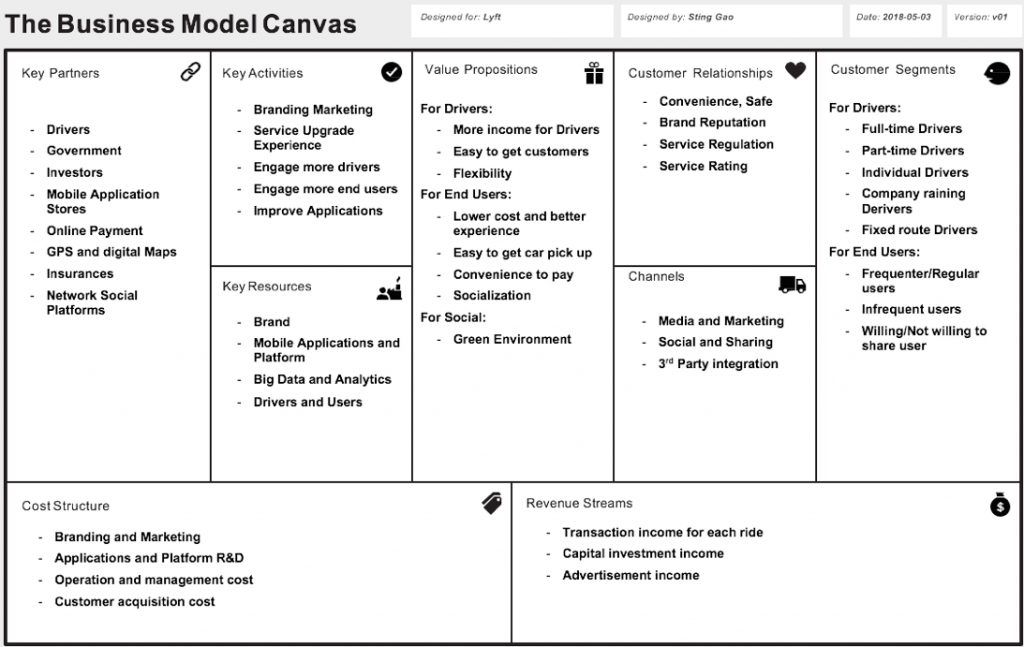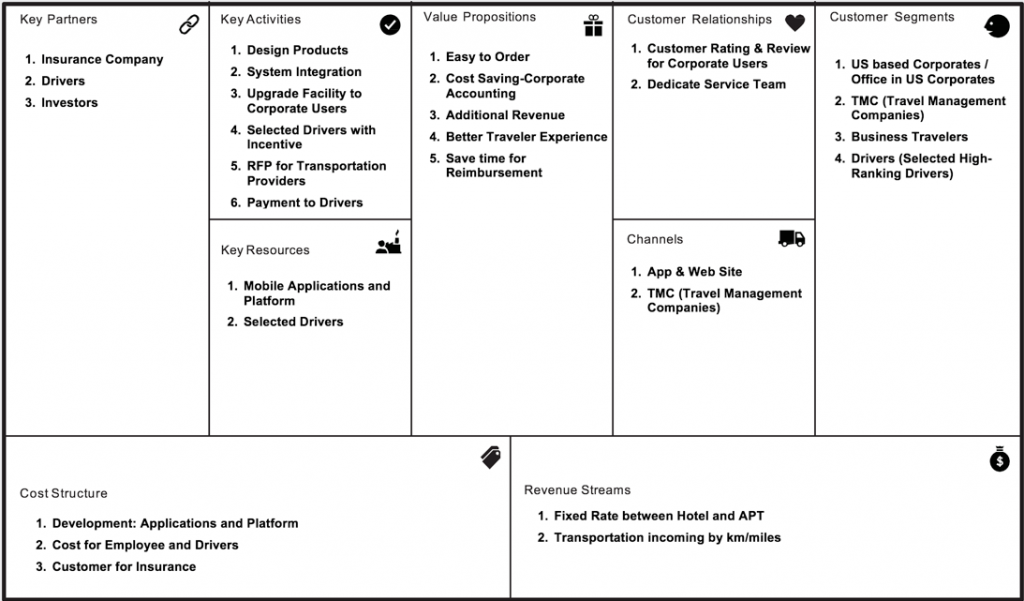1. About Lyft
According to the definition of sharing economy, “peer-to-peer based activity of obtaining, giving, or sharing the access to goods and services, coordinated through community-based online services”, Lyft is a typical sharing economy company by provide on-demand ride-sharing service that connects passengers with available drivers. Drivers use their personal cars and receive ride requests through the Lyft app. Lyft drivers don’t need a special commercial license to drive for Lyft, but all drivers must have a clean driving record and must pass a background check.
Lyft mobile application which promotes and arranges something they refer to as “ride sharing,” and is ultimately intended to be a friendly and reliable alternative to traditional taxi cab rides.
Once you’ve downloaded this application to your Android or iPhone, you can use it to simply click and find a ride in your area to your next location, as long as it is during Lyft’s hours of operation. These hours will vary depending on the city you live in, but they do span the majority of the day regardless of the locations.
The drivers for Lyft are described as being friendly, community-oriented people who volunteer their time and vehicles to this cause in exchange for “donations.” Lyft drivers must be at least 23 years of age and drive a car that is a year 2000 or newer, and in good working condition.
On Rider side, user can request a Lyft ride through:
- The Lyft app which download from mobile application store.
- Desktop or mobile browser by open http:// ride.lyft.com.
- Siri, on iOS 10 or higher device with Lyft app installed, tell Siri: “Book a Lyft”.
- Apple Watch OS3 or higher, open the Lyft app on your Apple Watch to set a pickup location different than Current Location, tap ‘Pickup at’ (above the ‘Request Lyft’ button).
- Apple Maps
There are a few different Lyft services that you can use in most cities. In a nutshell, a request for a Lyft will send to you a 4-seater car. A request for a Lyft Plus will send to you a car that can seat 6 or more passengers. Lyft Line is a ride sharing service for commuters who want to split the cost of a ride with strangers. Lyft Premier and Lux are higher-end services when you want to pay more for a nicer car. Here is the detail about the difference between Lyft, Lyft Plus, and Lyft Line, and Lyft Premier:
- Lyft is an on-demand ride that seats up to four passengers.
- Lyft Plus is a minivan or SUV that seats put to 6 passengers. It is more expensive than Lyft
- Lyft Line pairs you with other Lyft passengers traveling along the same route. Split the cost of the ride. The cheapest Lyft services.
- Lyft Premier is a luxury sedan that seats 4 passengers
- Lyft Lux is the most luxurious and most expensive option. Newer black luxury sedans and SUVs and highly rated drivers
On Drivers side, drivers must be able to pass a phone screening, an in-person meeting, and two different background checks, one DMV based and the other a basic background. Finally, drivers must have an Android phone or an iPhone so they can connect with their passengers through the application.
Once a driver has picked up a passenger and completed their ride, the passenger’s phone will beep with a message from the app, recommending a suggested donation. This donation is completely voluntary and be adjusted to be higher or lower than the suggested amount.
Lyft has strict policies about the behavior of both their drivers and their passengers. One way they ensure the respectful behavior of participants is to allow drivers to rate their passengers after every ride. Future drivers will be able to see these ratings before they accept a passenger.
Drivers will receive 80% of the donations from the passengers, and drivers will receive direct deposit payments into their accounts once a week. The website says that on average Lyft drivers will receive $35 per hour of work, and can choose their own hours.
2. The Business Model Canvas of Lyft
According to above analysis, describe of the Business Model Canvas as below:
3. The New Solution about Lyft extend to Business Market
Travel expense is usually a big part of the total cost for every US based corporation and/ or MNC who has offices in US, which include ground transportation such as taxi and car rental. The need of reducing travel cost is very important. The new business idea is to solve the problem and benefit these corporations on ground transportation spending based on existing strong sharing economy platform and technology.
CUSTOMER SEGEMENT:
There are 4 customer segments in this new business model. 1) The first is US based corporations and/ or MNC who has offices in US, and the employees travel either domestically in US or from other countries to US. 2) Normally, these US based company outsource the travel service to big travel management company, such as American Express. 3) Business travelers are also key customer since they are the person who will use the service. 4) Finally, drivers are also key customer for Lyft because they are providing the service to these business travelers. These drivers need to be selected by certain criteria and qualified to ensure the good customer experience.
VALUE PROPOSITION:
In this model, the corporation gets the value in cost saving and higher employee satisfaction of travel experience. The employees do not need to wait for a taxi in a long queue and their travel experience will be improved. Also, the invoice will be interfaced with corporate imbursement systems, which will save time and more convenient for employee’s reimbursement procedure.
For Lyft drivers, they can receive more stable orders and more incentive for serve business travelers, so their income will increase accordingly.
KEY PARTERNSHIP:
Safety and high-quality experience are two of the most important concerns for both corporate and employees, so in this model, Lyft will have partnership with insurance company to address the concern on safety.
The drivers are who delivered the high-quality service to business travelers, so they are key to customer experience.
Any new business model need investment for building up and scaling up, so the investors is also a key pattern.
CUSTOMER RELATIONSHIP:
To keep the service level for corporate clients, Lyft will dedicate a corporate client service team to provide a high-quality service. To ensure receiving the feedback from these corporate client, a special review & rating system will be prepared for corporate clients. After feedbacks collected, Lyft will ensure service improvement in the future.
KEY ACTIVITIES:
Lyft will design a corporate product which includes driver selected certain criteria, upgrade car facilities to meet business traveler needs like power supplier for laptop, in-car WIFI etc., proposed an extra incentive for drivers and offer an instant payment to drivers who will service corporate clients. Developing work for system integration for support the new business will also be planned. Then, Lyft will prepare bidding documents for these corporate’s annual RFP meeting.
KEY RESOURCE:
Lyft provides powerful Platform and Mobile Applications for the daily on-demand ridesharing service. Once you’ve downloaded this application to your Android or iPhone, you can use it to simply click and find a ride in your area to your next location, as long as it is during Lyft’s hours of operation.
In this new business model, Lyft can development and open the 3rd party integration interface with Corporate Travel System, so corporate travel users can easily use Lyft services through corporate applications and pay through corporate accounts.
Lyft will also provide selected Drivers and Cars for corporate travel users according to the integrated travel system reservation system. Normally, there are a few different Lyft services that can use in most cities. In a nutshell, a request for a Lyft will send to a 4-seater car. A request for a Lyft Plus will send to you a car that can seat 6 or more passengers. Lyft Line is a ride sharing service for commuters who want to split the cost of a ride with strangers. Lyft Premier and Lux are higher-end services when you want to pay more for a nicer car. In this case, Lyft can provide higher-end services cars for corporate travel users with selected high-ranking drivers.
CHANNEL:
They can promote their brand and events through App/Website and TMC(Travel Management Company), it’s easier& broader way to approach customers ,which is also good to build the brand image. Lyft can promote the new service through App/Website and TMC (Travel Management Company), it’s easier and broader way to approach customers, and is also good to build the brand awareness. In the long run, it’ll help Lyft to attract new users even during their personal trip.
REVENUE STREAM:
In Lyft new idea business model Lyft builds new customer segment-corporate market, with this new business development Lyft can get solid revenue streams to improve its financial condition.
Firstly, Lyft can charge fixed rate fee between hotel and airport travels. Secondly, the transportation income Miles or KMs can be based on corporate discounted rate. Corporate customers have repeated demands with a large user base, even Lyft provide additional discounts, it is quite profitable.
For corporate market, If you successfully get the customers you will also build somehow system connection with these corporates, later switching cost would be high, so the revenue will be more sustainable. In Lyft new idea business model Lyft builds new customer segment-corporate market, with this new business development Lyft can get solid revenue streams to improve its financial condition.
COST STRUCTURE:
The cost structure will include 3 parts:
First of all, we will develop the new B2B car calling platform which may be the majority kickoff cost. We will hire a consulting agency to do market research and business process design; then develop the prototype of the app and H5 for customer interface; prepare the IT infrastructure, hardware and software; also applying additional insurance for all business passengers.
Secondly, since that’s a new business, we will also have relevant cost of people, like recruit B2B business experts, project manager, and sales force team. Also, we will have a dedicated training and support team for drivers to help them provide qualified services fitting to our B2B service level.
Third cost we plan is an aggressive Marketing budget. We plan to launch several waves acquisition campaign to educate the market of our new B2B business; customer loyalty program dedicated for business travelers will also be implemented to ensure end user has motivation to use our new solution.The cost structure will include 3 parts: First of all, we will develop the new B2B transportation ordering platform which may be the majority kickoff cost. We will hire a consulting agency to do market research and business process design; then develop the prototype of the app and H5 for customer interface; prepare the IT infrastructure, hardware and software; also, applying additional insurance for all business passengers. Secondly, since that’s a new business, we will also have relevant cost of people, like recruit B2B business experts, project manager, and sales force team. Also, we will have a dedicated training and support team for drivers to help them provide qualified services fitting to our B2B service level. Third, Lyft’s expanding plan needs an aggressive Marketing budget. We plan to launch several waves acquisition campaign to educate the market of our new B2B business; customer loyalty program dedicated for business travelers will also be implemented to ensure end-user has motivation to use our new solution.
4. The New Business Model Canvas for Lyft 2B Market
Combined with the above analysis, the new Business Model Canvas for Lyft to Enterprise market as follows:
The above content is for reference only as my personal analysis of sharing economy.
获取更多资讯,欢迎关注微信公众号: atSting,或访问网址:www.atSting.com






